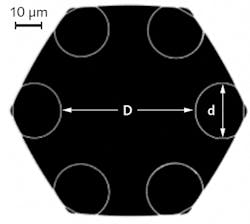Gas-filled photonic-crystal fiber produces supercontinuum from 300 nm to 3.1 μm

Supercontinuum light can be generated by pumping a small-diameter optical-fiber core with laser light to produce nonlinear optical effects in the core. Such devices are useful in light sources for microscopy and, because of the wide bandwidth, as a source for synthesis of ultrafast light pulses. This concept forms the basis of a number of commercial light sources, in fact. As for experimental devices, pushing the limits involves increasing bandwidth and/or average power. Because conventional silica fiber cores absorb mid-infrared (mid-IR) light (limiting potential bandwidth) and can be damaged by high-enough intensities (limiting output), photonic-crystal fibers (PCFs) filled with a suitable optically nonlinear gas have become the darlings of researchers. Now, a group from Max Planck Institute for the Science of Light (Erlangen, Germany) and Heriot-Watt University (Edinburgh, Scotland) has created a hollow-core single-ring PCF (SR-PCF) filled with krypton that generates a supercontinuum that extends from 300 nm to 3.1 μm, or from the UV to the mid-IR. Among other uses, the source opens up applications in mid-IR microscopic imaging and optical coherence tomography (OCT).
The fiber is hexagonal, with a single ring of six nontouching 21 μm silica capillaries, one at each of the six corners, defining the central core, which has a diameter of about 51 μm. The walls of the capillaries are only 280 nm thick. While many gas-filled PCFs have a complicated kagome geometry that results in a correspondingly complex transmission spectrum, the simpler geometry of the SR-PCF leads to a relatively flat transmission spectrum in comparison. The zero-dispersion-wavelength (ZDW) of the SR-PCF can be tuned to be anywhere from the visible to the near-IR, which allows soliton pulses to be generated from near- or mid-IR pulses. To produce the supercontinuum, the researchers pumped the fiber with light from an optical parametric amplifier (OPA) tunable between 1.6 and 2.3 μm that produced transform-limited 28.5 fs pulses with energy up to 100 μJ. Gas pressure, input pulse energy, or type of gas can be changed to vary properties of the fiber emitter. If pulse compression is added, the SR-PCF could be made into a producer of few-cycle optical pulses. Reference: M. Cassataro et al., arXiv:1701.07392v1 [physics.optics] (Jan. 26, 2017).
About the Author
John Wallace
Senior Technical Editor (1998-2022)
John Wallace was with Laser Focus World for nearly 25 years, retiring in late June 2022. He obtained a bachelor's degree in mechanical engineering and physics at Rutgers University and a master's in optical engineering at the University of Rochester. Before becoming an editor, John worked as an engineer at RCA, Exxon, Eastman Kodak, and GCA Corporation.
